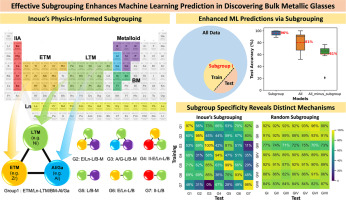Keywords
Machine learning
Materials discovery
Materials informatics
Metallic glass
Glass-forming ability
© 2023 The Authors. Published by Elsevier Ltd on behalf of Acta Materialia Inc.

Addressing complex materials science problems through machine learning (ML) is challenging. A primary reason for the challenge is that the underlying mechanisms may vary within the considered problem space. To quantify this, we divide alloy data into subgroups and construct ML models to predict metallic glass formation. We discover that subgrouping guided by physical insights into the problem leads to significantly higher prediction accuracy. Specifically, when applying Inoue’s subgrouping, models specific to subgroups outperform those trained on the entire dataset. Moreover, our analysis uncovers distinct mechanisms and contributing factors that control the glass-forming ability in different subgroups, shedding light on the diverse nature of this phenomenon. Statistical methods for subgrouping prove less effective and constrained when compared to physics-informed subgrouping. Our results underscore the importance of leveraging physical insights for effective subgrouping or precise feature representation, to guide ML strategies when tackling complex materials science problems. Such an integrated approach has the potential to unlock new insights into material composition-property relationships and accelerate materials discovery in a wide range of applications beyond metallic glass formation.
Machine learning
Materials discovery
Materials informatics
Metallic glass
Glass-forming ability
© 2023 The Authors. Published by Elsevier Ltd on behalf of Acta Materialia Inc.
Add Comment